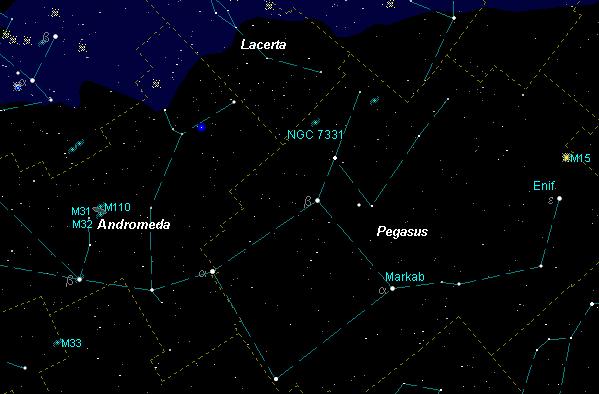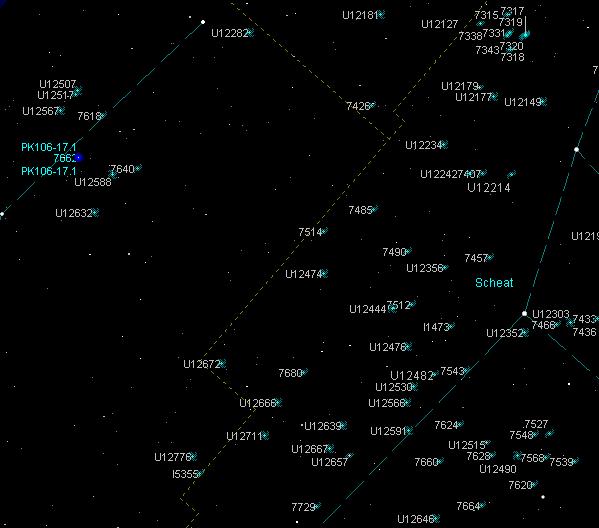Pegasus – The Winged Horse
In mythological times, the winged horse Pegasus carried its master Perseus and rescued Andromeda to safety after Perseus saved her from the sea monster Cetus. This is a classic tale of heroism in the night sky. But for backyard astronomers and stargazers, The Great Square of Pegasus spells fall observing. This giant baseball diamond in the sky is quite easy to locate. With the splendid Milky Way perched straight up after sunset, the winged beast ascents in the east.
I referred to the square as a baseball diamond when pointing out the Andromeda Galaxy aka M31 at star parties. I use the route of taking third base, moving two stars down to the dugout, and then two rows up in the stands. Our target is at the one o’clock position. First-timers find this a fun and interesting way to find our magnitude 3.5 neighbouring galaxy. This is an easy naked-eye target.

This remarkable object should be at the top of your fall observing list. Moderate size instruments and a dark site will yield a couple of the galaxy’s arms as well as the star cloud catalogued as NGC 206, situated at the west end of the main galaxy. M31 also possesses two satellite galaxies called M32 to the west and about 25 arc minutes from NGC 206, and M110 to the north of M31’s core.
Both these satellite galaxies are elliptical in nature and are listed as magnitude 8.2 and 8.0 respectively. However, since M110’s area is spread out over a wide area – it appears fainter than M32. The parent galaxy possesses many globular clusters with observers with large telescopes can see. All galaxies have globular clusters embedded in them; however, we take advantage of the short distance of 2.9 million light-years (ly) from us.

The star Enif is known as the nose of the winged horse and is a K type supergiant. Cooler than our Sun, Enif’s surface temperature is about 4,460 Kelvins but is 10 times more massive than Sol. In fact, if you would place Enif as our daytime star, it would measure some 40 degrees across the sky or from the alpha star Alpheratz to Enif. Not a pretty picture. Lying 670 ly from us, Enif is beginning to fuse helium into carbon and oxygen which means it seems to be on its last legs of life. Not too far from Enif is the only globular cluster in this constellation. M15 is a wonderful magnitude 6.2 and is a well-resolved cluster that is a must for your observing session. Sitting 33,600 ly from us, it takes about half a lunar width of sky.
Aside from the showpiece Andromeda, many other fine and challenging objects await you. My next favourite target is NGC 7331. Commonly known as the Deer Lick, it measures 10 X 3 arc minutes and glows nicely at magnitude 9.5. It contains a nice bright core with its galactic rings swinging off to one side. At 40 million ly distance NGC 7331 can also be seen with five 15th magnitude remote galaxies. The Deer Lick galaxy is an excellent guidepost to lead you to the sometimes challenging Stephan’s Quintet. The quintet is made up of four what appear to lay 280 million ly away and a foreground one at only 35 million ly.

Let’s now move a bit more than six degrees southeast of NGC 7331 and you will find NGC 7457. It is farther at 48 million ly and lists at magnitude 12. Its elongated dimensions are only 1.5 X .8 arc minutes making it a bit of a challenge.
About three degrees southwest of Markab is a nice 11th magnitude barred spiral galaxy catalogued NGC 7479. With a length of 4.3 arc minutes, it is a decent-sized object to hunt down. An interesting combination consists of a very sparse open cluster IC 1465 next to NGC 7468, a 14th magnitude galaxy. It would be worth your while trying to locate this pair. A little more than a moon’s width south of IC 1465 is the triple galaxy system of NGC 7463, 64, & 65. With respective values of magnitude 13, 14 and 13, NGC 7463 is very elongated and is a contrast to the other two ellipticals. These cosmic islands occupy a mere three arc minutes of sky.
Venus is slowly making its ascension in western skies after sunset. As September begins, it forms a nice triangle along with Mars to the left and Mercury below. As the weeks and months go by, it climbs higher will it meets up with Jupiter in December. Speaking of Jupiter, it lies on the meridian above the handle of the teapot in Sagittarius at dusk. At magnitude -2.5 it is easily the first object breaking through the darkening sky. The King of planets sets about four hours later.
The Harvest Moon occurs on September 15th and fall commences a week later on the 22nd. Now the night hours will exceed day time hours.
Till next month – clear skies everyone.
Gary Boyle
| Object | Type | Magnitude | R.A. | Dec. |
|---|---|---|---|---|
| M 31 | Galaxy | 3.5 | 00h 42m 42.0s | +41° 16' |
| NGC 206 | Star cloud | 7.6 | 00h 40m 36.0s | +40° 44' |
| M 15 | Globular cluster | 6.4 | 21h 30m 0.0s | +12° 10' |
| NGC 7331 | Galaxy | 9.5 | 22h 37m 6.0s | +34° 24' |
| Stephan’s Quintet | Galaxy group | 13.5 | 22h 35m 53.9s | +33° 57' |
| NGC 7457 | Galaxy | 10.8 | 23h 01m 0.0s | +30° 09' |
| NGC 7479 | Galaxy | 11.0 | 23h 04m 54.0s | +12° 19' |
| NGC 7468 | Galaxy | 14.0 | 23h 03m 0.0s | +16° 36' |
| NGC 7463 | Galaxy | 13.2 | 23h 01m 54.0s | +15° 59' |
